Should You Upgrade Your DSLR? Full Frame vs Crop Sensor
Want to upgrade your camera body but you're not sure whether you should get a full frame vs. a crop sensor? This guide will help walk you through the pro's and con's of each choice with side-by-side photos using the same lenses so you can see the difference between the two camera models.
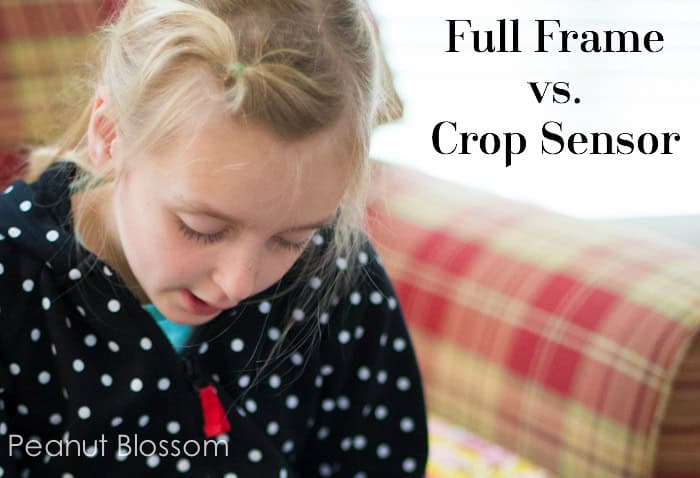
For newer photographers there is usually a great deal of confusion about the difference between focal lengths on lenses and what it means to have a full frame vs a crop sensor on your camera body.
When you are frustrated with your images, most people automatically turn to upgrading their camera body but if all you have is the kit lens that came with your camera, investing in high quality lenses will actually do a lot more to help you.
- But how do you know when it is time to finally move to a better camera body?
- What's the difference between a full frame vs crop?
- How do you know if you need one?
I pulled out my Canon Rebel T1i (crop sensor) and my Canon 6D (full frame) and my 35mm f/2 and 50mm f/1.4 to take some sample shots to help you decide.
All photos in this post feature the Rebel on the left and the 6D on the right. In each pair of images, I am using the same lens with the same settings unless otherwise noted. All shots are SOOC (straight out of camera, no editing) unless noted. I also shoot in RAW.
So here we go . . .
Full Frame vs Crop: Which One Do I need?
Sample 1:
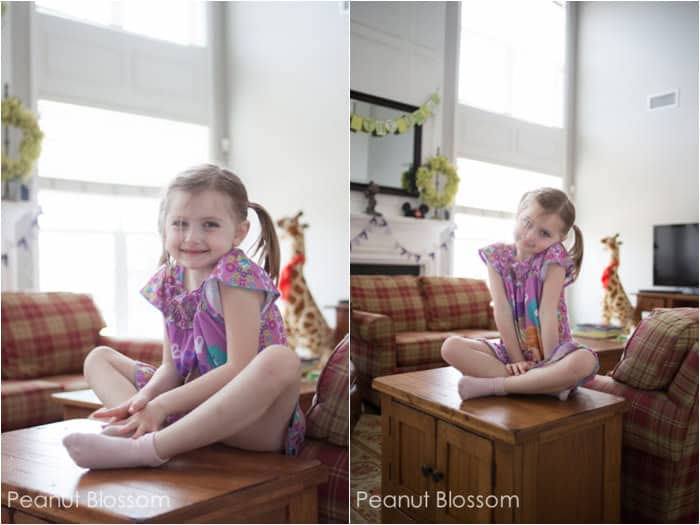
Lens: 35mm f/2
Settings: 1/1250, f/2, ISO3200
Notes: I am standing in the exact same position for both of these shots. The obvious difference is that even with the same lens in the same standing position, how much more of the scene I am able to capture with the full frame camera on the right.
To capture more of the scene, you generally have 3 choices:
- Zoom out if you have a zoom lens.
- Step backwards if you have a prime.
- If you've zoomed out as far as you can go and stepped back as far as you can, the only way to capture more is a full frame camera.
This was Reason #1 I upgraded. Wider angle lenses (anything with a lower number than a 35mm) start having very distracting fisheye type distortion. In order to capture more of the environment in my shots inside my home, I needed the full frame.
Walls prevented me from backing up as far as I wanted and there are times I need to capture the whole room (or most of it.) For lifestyle photography of children, the environment is crucial to the subject matter and it is wonderful to have the flexibility of capturing the space.
Sample #2:
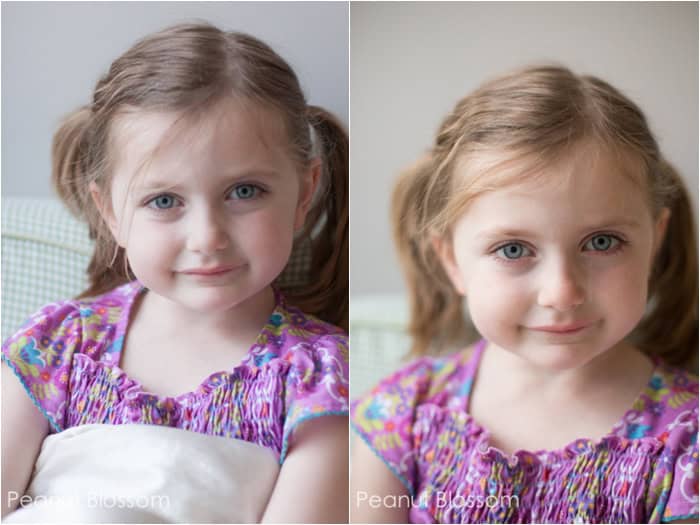
Lens: 50mm f/1.4
Settings: 1/1000, f/2, ISO 800
Notes: I sat Little Pea down by a window and took both of these shots sitting across from her in the exact same spot. Even with the exact same lens and settings, look at the difference in the colors straight out of the camera. The full frame provides richer and warmer colors and the light is softer. The bokeh is also more pronounced. I feel like I am starting with a more accurate representation of the scene with the 6D than with the Rebel, though editing can fix a lot. Which leads us to . . .
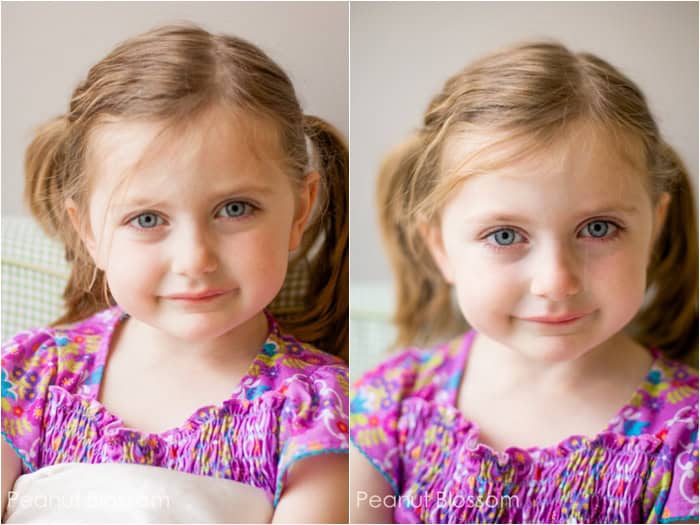
This is the same set of photos with a simple edit. I use Lightroom for everything (LOVE it!!!) and have several sets of presets I turn to for most of my images. To edit these photos and provide the best "apples to apples" comparison, I used the exact same preset on both of them and tried to crop them so they would be framed as similarly as possible.
With the same editing, the colors feel perfect in the one on the right, the one on the left feels too intense--especially in her hair and on her face. Part of this has to do with the fact that image file from the full frame is so much bigger than the crop sensor that it can handle significant amounts of editing far better than the smaller file.
But there's an even more important difference that is hard to tell with the images at that size. When you crop much closer in, look at the difference in sharpness on her eye:
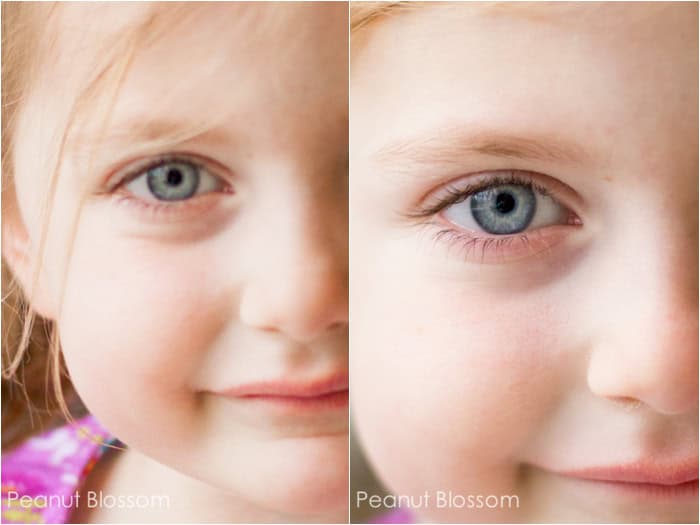
The 6D full frame provided excellent crispness when cropped in. I could have gone in even closer and the quality of the image is so strong the image would still hold up.
Sample 3:
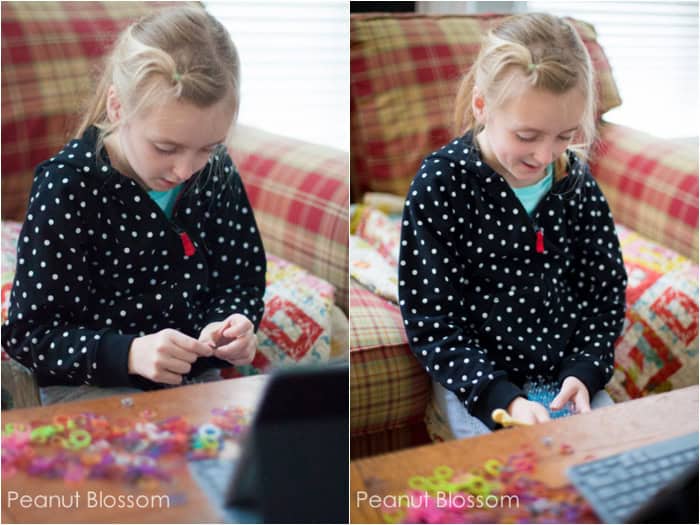
Lens: 50mm f/1.4
Want to Save This for Later?
Settings:
LEFT: 1/500, f/1.4, ISO 3200
RIGHT: 1/500, f/1.4, ISO 5000
Notes: The strongest reason you might consider a full frame camera is the additional options it provides for your ISO. My Peanut is home sick from school today and playing with her rainbow loom in a dimly lit living room. The image on the left maxes out the Rebel's ISO at 3200. I'm using my very best light seeking lens at it's most open setting.
On the right I was able to bump up my ISO to 5000 while keeping my other settings the same. I can immediately see the difference between the two images, but small here in a blog post, it is tricky to tell.
Check out this zoomed in crop of the same images as above to see things better:
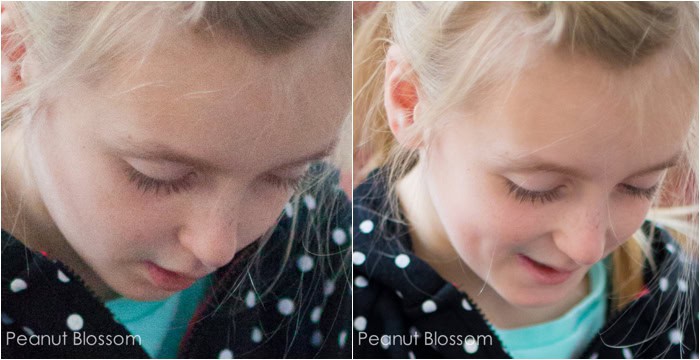
Notice the grain on her face on the left? The full frame captured a smoother, brighter, more colorful image. On top of that, the image has more megapixels than the Rebel so it gives significantly greater room for editing and cropping.
And this was taken at 10am on a cloudy day indoors. The difference is even more significant at twilight. The grain on my Rebel can be horrid above ISO800 but the 6D can go all the way up to ISO 120,000!!!
You might be thinking, "But my images are usually small enough on my site that it doesn't matter what they look like this cropped down." And that might be very true. But with a 6D, the image files are so much bigger you have lots of wiggle room for cropping.
Take a look at this example:
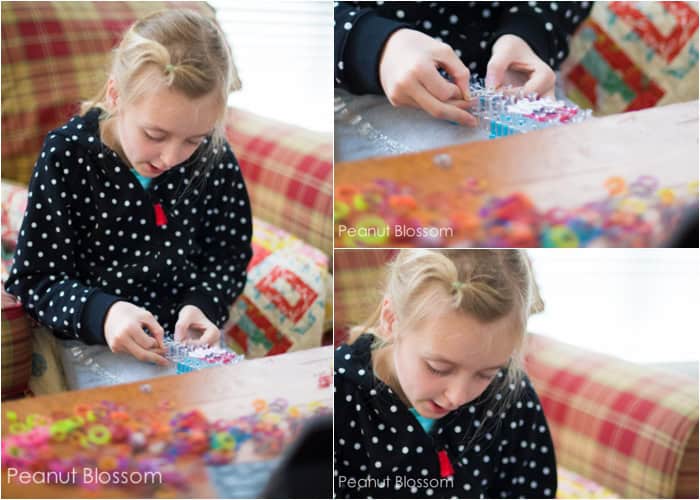
These three images are all the same file. I took the original picture on the left and was able to crop in on her hands and a third version on her face. Now I have 3 very different images--1 vertical, 2 horizontal-- all from one picture.
For a blogger, this means you could potentially shoot less images in a session or salvage a session gone wrong by cropping in on details within the shot to provide variety for your blog post and social media promotions.
I could use this one for a title image on the post:

And this one as the main image for Facebook:
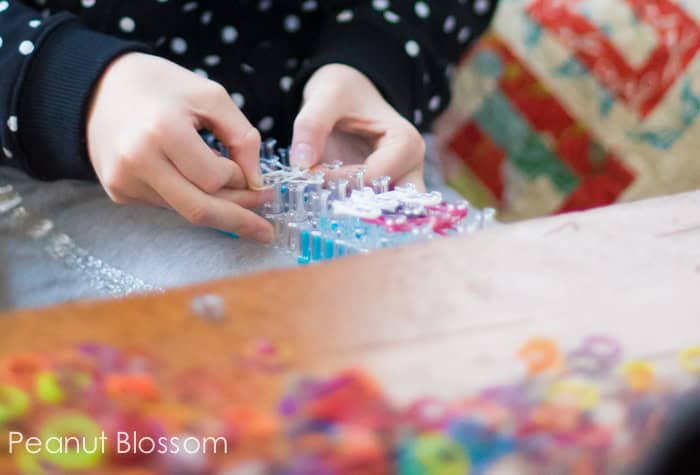
Remember that eye shot above? On the Rebel, the quality is just not there for cropping in so closely on those details in this way. You'd have blurry, grainy hands rather than these crisp ones.
And here's a bigger look at the original, the perfect orientation for using either within the blog post itself or as part of a pin on Pinterest:
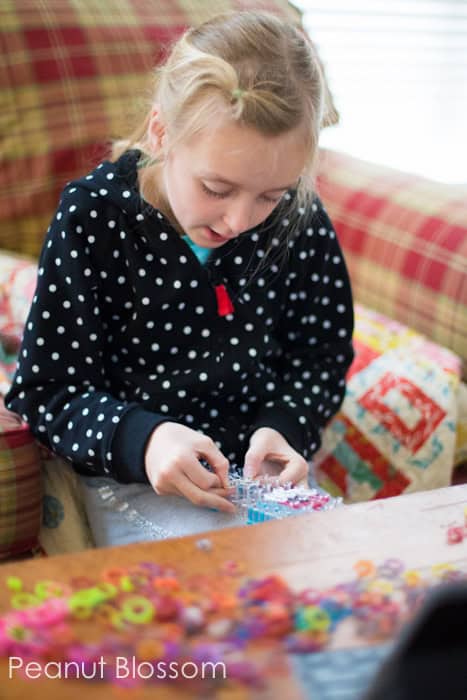
So let's review:
The pro's of a full frame camera body with a quality lens:
- sharp
- better quality color
- better bokeh
- captures more of the scene
- higher resolution that allows for massive cropping and editing control
- more ISO capability that reduces grain in low light
The con's of a full frame:
- very expensive: definitely the heaviest weighted con
- larger, heavier, bulkier than smaller DSLRs
Do you need one? There's no easy answer to this, but I would consider these questions:
- Do you own one fixed aperture prime lens or zoom?
- Do you print your images in sizes 8x10 or larger or ever need a high resolution image for publishers?
- Do you often have to shoot in poor lighting conditions?
- Do you get frustrated with botched sessions and don't have the time to reshoot?
- Do you know how to do basic edits, preferably in Lightroom or Photoshop?
- Does your photography affect your business?
If you can say "yes" to all of those, you should definitely be considering an upgrade to a full frame but only after you have at least one high quality prime or zoom lens for your current camera.
Ready to upgrade? Here is the gear I recommend in this post:
Want to see what else is in my camera bag? You can find all the tools I use here.


I didn't see this until now but for all the reasons you said I went full frame a couple weeks ago. So glad to have reinforcements with my decision. Now for photography season to get here. Thanks. Loved the article.
I thought this was a great post, very informative! thank you!!
Hhi,
You confuse an older vs new camera with crop vs full frame!
The differences are slightly different. See http://www.speedlighter.ca/2015/03/26/full-frame-or-crop/ for a comparison.
Good luck, and keep up the good work.
Michael
Unless you are a pro, there is NO NEED for a 2K camera body. This is just going to fuel the momtographers out there who think they can start a business because they take pics off their kids, meanwhile they can't even work the basics of a point and shoot. It's too much camera for the every day person (who, i assume this blog is aimed towards!) And most importantly, a more expensive camera doesn't give someone more talent. If you aren't a good photographer already, this won't help!
Respectfully, this is a BAD comparison. You are comparing an older, less technically advanced crop sensor camera to what is practically a state of the art full frame sensor camera.
A better comparison would be between cameras of similar levels of technology -- for the Canon world that would be the crop sensor 7d mkII vs 6d. There is only about a $200 price gap between them. The differences come down to slightly shallower depth of field for the full frame 6d, which makes for a more pleasingly 'blurred' background when shooting at wide (numerically low) apertures. The crop sensor 7d mkII has slighter more magnification, which even for youth sports is a nice plus.
In point of fact many folks would advocate that the slight differences in crop sensor vs full frame is almost silly and you are better off focusing on which lenses to bring along -- http://www.kenrockwell.com/tech/assembling-a-system.htm